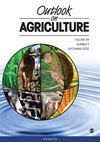Digital traceability to enhance circular food systems and reach agriculture emissions targets
IF 2.6
3区 经济学
Q1 AGRICULTURE, MULTIDISCIPLINARY
引用次数: 1
Abstract
How can digital tools increase national circularity measures in agriculture towards GHG reduction and other national goals? During the 26th Conference of Parties (COP) held in November 2021, it was clear that circularity will play a role in meeting important international targets but that the global community and national governments lack the tools to measure the contribution of circular actions in the agriculture sector towards meeting these commitments. In the absence of monitoring and decision-support tools, governments will not know the full impact of their actions towards meeting commitments. This perspective looks at the way that digital agricultural traceability systems can form the building blocks for government action to incentivize enhanced circularity in the agriculture sector and track progress towards international targets. Among the many countries working on digital traceability systems, Uruguay stands out an example of a country pushing towards systemic traceability in multiple aspects of the food system. We examine Uruguay's use of digital traceability systems for sustainable production and redefinition of green markets as an example of a rapidly modernizing digital food system and a beacon for other countries to follow. The case of Uruguay shows that digital tools can create transparency in productive systems and allow the government to target sustainability policies. By using digital traceability systems for livestock, dairy effluents, soil rotations, agricultural chemicals, and forests Uruguay is creating a replicable framework for circularity and long-term sustainable production in the agriculture sector, one policy at a time. This framework serves as a benchmark for other countries in Latin America to reach their traceability, circularity, and emissions reductions targets.数字可追溯性,以加强循环食品系统并实现农业排放目标
数字工具如何增加国家农业循环措施,以实现温室气体减排和其他国家目标?在2021年11月举行的第二十六届缔约方大会上,很明显,循环性将在实现重要的国际目标方面发挥作用,但国际社会和各国政府缺乏衡量农业部门循环行动对实现这些承诺的贡献的工具。在缺乏监测和决策支持工具的情况下,各国政府将不知道其行动对履行承诺的全面影响。这一观点着眼于数字农业追溯系统如何成为政府行动的基石,以激励农业部门增强循环性,并跟踪实现国际目标的进展。在致力于数字可追溯系统的许多国家中,乌拉圭是一个在食品系统的多个方面推动系统可追溯的国家的典范。我们审查了乌拉圭使用数字可追溯系统进行可持续生产和重新定义绿色市场的情况,将其视为快速现代化的数字食品系统的一个例子,也是其他国家效仿的灯塔。乌拉圭的案例表明,数字工具可以在生产系统中创造透明度,并使政府能够制定可持续发展政策。通过使用牲畜、奶制品废水、土壤轮作、农用化学品和森林的数字可追溯系统,乌拉圭正在为农业部门的循环性和长期可持续生产创建一个可复制的框架,一个政策一个政策。该框架是拉丁美洲其他国家实现其可追溯性、循环性和减排目标的基准。
本文章由计算机程序翻译,如有差异,请以英文原文为准。
求助全文
约1分钟内获得全文
求助全文
来源期刊

Outlook on Agriculture
农林科学-农业综合
CiteScore
5.60
自引率
13.30%
发文量
38
审稿时长
>36 weeks
期刊介绍:
Outlook on Agriculture is a peer reviewed journal, published quarterly, which welcomes original research papers, research notes, invited reviews and commentary for an international and interdisciplinary readership. Special attention is paid to agricultural policy, international trade in the agricultural sector, strategic developments in food production, the links between agricultural systems and food security, the role of agriculture in social and economic development, agriculture in developing countries and environmental issues, including natural resources for agriculture and climate impacts.
 求助内容:
求助内容: 应助结果提醒方式:
应助结果提醒方式:


